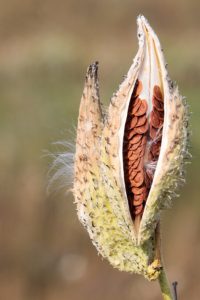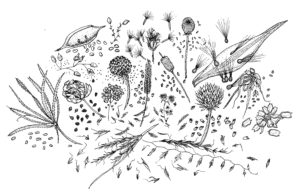January and February can be dull months for a gardener. When the north wind whips and the drizzle freezes, spring seems a lifetime away. But here at the Arboretum these cold months are a busy time for seed treatment. Seeds we’ve collected and ordered are prepared according to their species-specific needs.
Stratification
There are many specific types of stratification: warm-moist, cold-dry, cold-moist, water-soak, etc. Many prairie wildflower species require a cold-moist stratification period, a sort of “man-made winter”. Seeds are amazingly self governing, with built-in mechanisms to prevent germination until conditions are suitable. For species that have spent thousands of years adapting to the Great Plains, this means reading and reacting to seasons: long, cold, moist winter gives way to spring. Aha, time to sprout! It is the stratifyer’s job to convince the seed that winter has come and gone.
Cold stratification involves
- first, mixing the seeds with media (sterile soil, sand, sphagnum moss, vermiculite)
- wetting it slightly (too much moisture and the seeds will rot, too dry and they won’t germinate)
- then storing in a refrigerator for a specified length of time
Each species is a little different – some need 60 days of cold, some need 120, and some just 10. Be sure to look up the requirements of each species if you are stratifying your favorites at home.

Common milkweed (Asclepias syriaca) seeds waiting to catch a breeze. 30 days of cold, moist stratification is all you need to germinate them for yourself.
Photo from: https://commons.wikimedia.org/wiki/File%3AMilkweed-in-seed.jpg
Scarification
Scarification is any process that weakens the seed coat, purposely making it more permeable to gases and water that trigger germination. In the wild, these seeds would only sprout after many years of freezing and thawing, or perhaps after being passed through the digestive tract of a seed eating animal. If you want to germinate tough-coated seeds for your own garden (and you don’t have the digestive tract of a bird) then you will need to simulate nature’s scarification processes. This is done by nicking seeds with a knife or rubbing with sand paper. Seeds naturally activated by wildfire may need to be treated with nearly-boiling water. Some seeds perform best after an acid bath! Every seed is unique.

Line drawing of prairie seeds by Lorna Harder. This is the featured graphic on our “Prairie Restoration” informational sign on the Arboretum grounds.
Fall Sowing Alternative
Fall sowing is often less work intensive than manual seed treatment. Let mother nature do the work of breaking the seed coat by sowing your seeds in late fall. The cycles of freezing and thawing mixed with intermittent winter moisture will produce much the same effect as the previously mentioned methods. But be patient – some seeds may take several years to germinate this way.
If you are looking for high quality native seed, Prairie Moon Nursery is a good source.
To find species-specific information on seed treatment, check out Growing Native Wildflowers by Dwight Platt and Lorna Harder, available in our gift shop.

